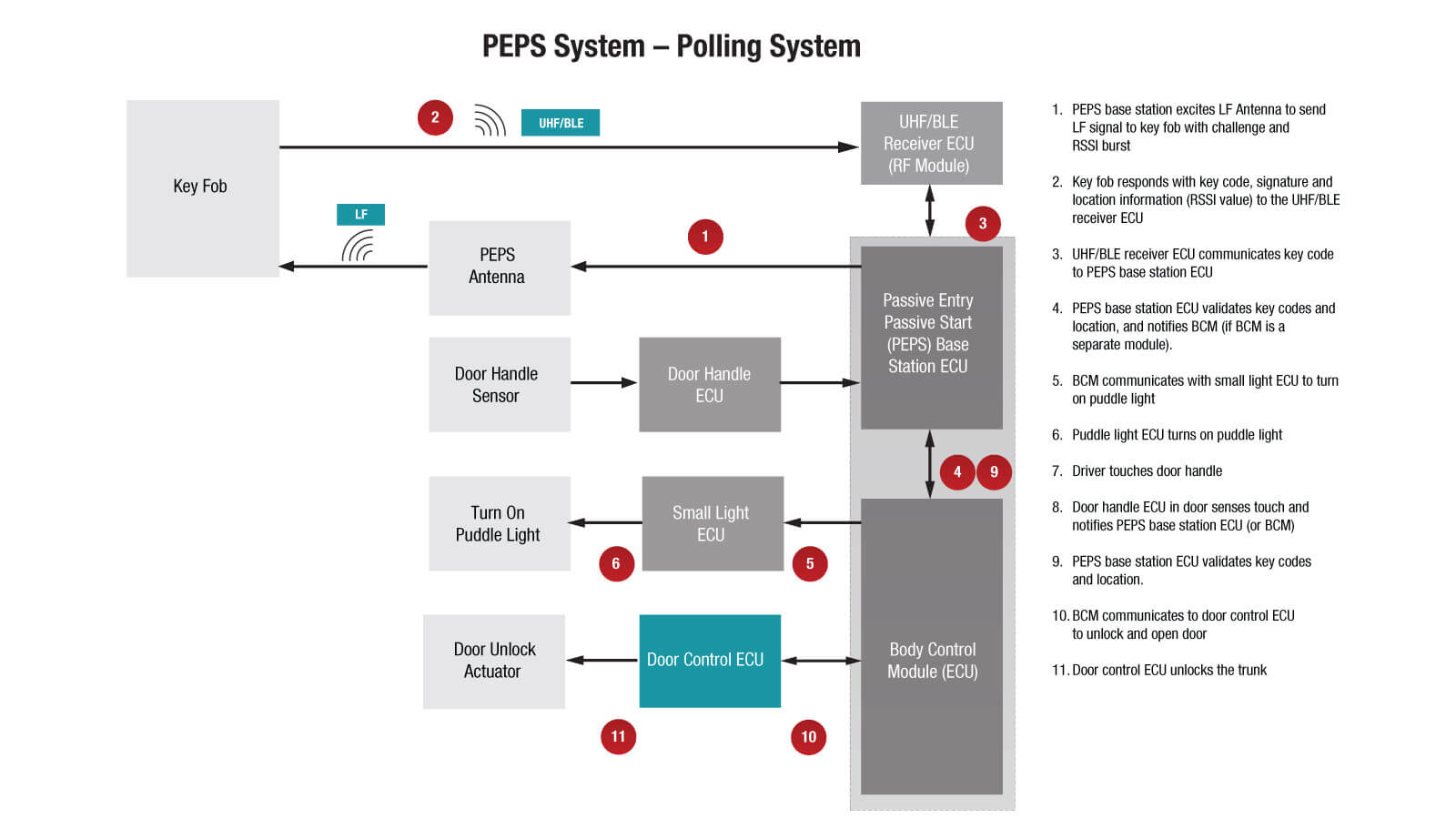-
How PEPS Technology Is Opening the Doors to the Evolution of Car Access Systems
How PEPS Technology Is Opening the Doors to the Evolution of Car Access Systems
Arun T. Vemuri
Car access has become more convenient as design engineers take advantage of technologies that are widely used in other applications. The automotive industry has evolved from providing mechanical keys to unlock vehicles to fobs with buttons that can unlock vehicles. Now, the most common form of car access revolves around passive entry passive start (PEPS) systems, enabling drivers to enter their car but also start the engine without physically using a key.
How Do PEPS Systems Work?
PEPS systems use radio-frequency (RF) communications between the car and key fob to both understand driver intentions and authenticate drivers. Low-frequency (typically 125 kHz or 134 kHz) and ultra-high-frequency (UHF) (typically Sub-1 GHz) signals communicate unique key access codes between the key fob and the vehicle. The car will only allow access functions if the exchanged codes match the expected values and the distance between the key fob and the vehicle is within a certain threshold. This measurement between the key fob and the vehicle detects both position and distance, and determines if the key is inside or outside the car. If the key is in close proximity but is still outside the car, the passive entry function should enable, but the passive start function will not be allowed.
PEPS systems can be either triggered systems or polling systems. In a triggered system, drivers initiate the process of car access by touching something on the car such as door handle, while in a polling system, the car access system continuously scans the vicinity of the car searching for the presence of a key.
Figure 1 and Figure 2 illustrate the entry sequence in triggered and polled systems, respectively.
 Figure 1 Triggered PEPS Entry Sequence
for Unlocking the Door
Figure 1 Triggered PEPS Entry Sequence
for Unlocking the Door Figure 2 Polling PEPS Entry Sequence
for Unlocking the Door
Figure 2 Polling PEPS Entry Sequence
for Unlocking the DoorUsing Bluetooth® Low Energy for Phone-as-a-key
Designers today are taking these advancements even further by making PEPS systems possible using a phone as a key (Figure 3).
 Figure 3 Enabling PEPS in
Phone-as-a-key Systems
Figure 3 Enabling PEPS in
Phone-as-a-key SystemsThe movement to introduce phone-as-a-key includes efforts to replace UHF with Bluetooth Low Energy technology. There are a number of reasons for doing so: the Bluetooth Low Energy standard is much more widely used than UHF. Communication is more standardized and more secure, and Bluetooth systems consume less power compared to UHF. Bluetooth Low Energy is already available in smartphones, and developing Bluetooth Low Energy-based car access systems will enable the use of smartphones for PEPS systems. A phone-as-a-key system goes further than drivers being able to keep their car keys in their pockets or purses – now they can even leave their keys at home. I can’t wait for the day when I can carry one less item with me.
Additional Resources
- Read more about the benefits of Bluetooth Low Energy for car access systems.
- Explore the automotive Bluetooth Low Energy car access satellite node reference design.
IMPORTANT NOTICE AND DISCLAIMER
TI PROVIDES TECHNICAL AND RELIABILITY DATA (INCLUDING DATASHEETS), DESIGN RESOURCES (INCLUDING REFERENCE DESIGNS), APPLICATION OR OTHER DESIGN ADVICE, WEB TOOLS, SAFETY INFORMATION, AND OTHER RESOURCES “AS IS” AND WITH ALL FAULTS, AND DISCLAIMS ALL WARRANTIES, EXPRESS AND IMPLIED, INCLUDING WITHOUT LIMITATION ANY IMPLIED WARRANTIES OF MERCHANTABILITY, FITNESS FOR A PARTICULAR PURPOSE OR NON-INFRINGEMENT OF THIRD PARTY INTELLECTUAL PROPERTY RIGHTS.
These resources are intended for skilled developers designing with TI products. You are solely responsible for (1) selecting the appropriate TI products for your application, (2) designing, validating and testing your application, and (3) ensuring your application meets applicable standards, and any other safety, security, or other requirements. These resources are subject to change without notice. TI grants you permission to use these resources only for development of an application that uses the TI products described in the resource. Other reproduction and display of these resources is prohibited. No license is granted to any other TI intellectual property right or to any third party intellectual property right. TI disclaims responsibility for, and you will fully indemnify TI and its representatives against, any claims, damages, costs, losses, and liabilities arising out of your use of these resources.
TI’s products are provided subject to TI’s Terms of Sale (www.ti.com/legal/termsofsale.html) or other applicable terms available either on ti.com or provided in conjunction with such TI products. TI’s provision of these resources does not expand or otherwise alter TI’s applicable warranties or warranty disclaimers for TI products.
Mailing Address: Texas Instruments, Post Office Box 655303, Dallas, Texas 75265
Copyright © 2023, Texas Instruments Incorporated